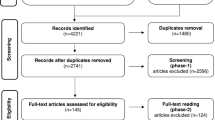Abstract
A prospective study of 60 patients with the temporomandibular pain and dysfunction syndrome (TMPDS) was done using the General Health Questionnaire, the Crown-Crisp Experiential Index, and the Parental Bonding Instrument. Three months after an initial visit 59 patients were reassessed: 18 patients were completely better or improved a lot, 27 were improved a little, and 14 were the same or worse. Patients' outcomes were not related to the severity or duration of symptoms at the initial presentation. Thirtyfive percent of the patients had not received any therapy in the 3-month interval. The outcomes of these patients were not different from the outcomes of patients who had received treatment. A significant relationship was found between initial psychological test scores and outcome (multivariate F=3.80, P <0.05). This relationship was curvilinear: the group with the worst outcomes scored highest, that with the best outcomes scored in the middle, and that with intermediate outcomes scored lowest. These results imply that mild psychological distress may facilitate a successful outcome, whereas either excessive psychological disturbance or minimal psychological complaint is associated with poor results.
Similar content being viewed by others
References
Ågerberg, G., and Carlsson, G. E. (1974). Late results of treatment of functional disorders of the masticatory system.J. Oral Rehab. 1: 309–316.
Brooke, R. I., Stenn, P., and Mothersill, K. (1977). The diagnosis and conservative treatment of myofascial pain dysfunction syndrome.Oral Surg. 44: 844–852.
Carraro, J. J., and Caffesse, R. G. (1971). Chronometry of the symptomatology and therapeutic response in patients with temporomandibular joint syndrome.J. Dent. Res. 50: 1161–1162.
Crown, S., and Crisp, A. H. (1966). A short clinical diagnostic self-rating scale for psychoneurotic patients: The Middlesex Hospital Questionnaire (M.H.Q.).Br. J. Psychiat. 112: 917–923.
Crown, S., and Crisp, A. H. (1970).The Middlesex Hospital Questionnaire (M.H.Q.) Manual, Psychological Test Publications, Barnstaple.
DeBoever, J. A. (1979). Functional disturbances of the temporomandibular joint. In Zarb, G. A., and Carlsson, G. E. (eds.),Temporomandibular Joint Function and Dysfunction, C. V. Mosby, St. Louis, pp. 193–214.
Goldberg, D. P., and Hillier, V. F. (1979). A scaled version of the General Health Questionnaire.Psychol. Med. 9: 139–145.
Goldberg, D. P., Kay, C., and Thompson, L. (1976). Psychiatric morbidity in general practice and the community.Psychol. Med. 6: 565–569.
Goodman, P., Greene, C. S., and Laskin, D. M. (1976). Response of patients with myofascial pain dysfunction syndrome to mock equilibration.J. Am. Dent. Assoc. 92: 755–758.
Greene, C. S., Lerman, M., Sutcher, H., and Laskin, D. M. (1969). The TMJ pain dysfunction syndrome: Heterogeneity of the patient population.J. Am. Dent. Assoc. 79: 1168–1172.
Heloe, B., and Heiberg, A. N. (1980a). A multiprofessional study of patients with myofascial pain dysfunction syndrome, II.Acta Odontol. Scand. 38: 119–128.
Heloe, B., and Heiberg, A. N. (1980b). A follow-up study of a group of female patients with myofascial pain dysfunction syndrome.Acta Odontol. Scand. 38: 129–134.
Laskin, D. M., and Greene, C. S. (1972). Influence of the doctor-patient relationship on placebo therapy for patients with myofascial pain dysfunction (MPD) syndrome.J. A., Dent. Assoc. 85: 892–894.
Marbach, J., and Dworkin, S. (1975). Chronic MPD, group therapy and psychodynamics.J. Am. Dent. Assoc. 90: 827–833.
Mavissakalian, M., and Michelson, L. (1981). The Middlesex Hospital Questionnaire: A validity study with American psychiatric patients.Br. J. Psychiat. 130: 336–340.
Millstein-Prentky, S., and Olson, R. E., (1979). Predictability of treatment outcome in patients with myofascial pain-dysfunction (MPD) syndrome.J. Dent. Res. 58: 1341–1346.
Parker, G. (1981a). Parental reports of depressives.J. Affect. Dis. 3: 131–140.
Parker, G. (1981b). Parental representations of patients with anxiety neurosis.Acta Psych. Scand. 63: 33–36.
Parker, G., Tupling, H., and Brown, L. (1979). A parental bonding instrument.Br. J. Med. Psychol. 52: 1–10.
Pomp, A. M. (1974). Psychotherapy for the myofascial pain-dysfunction syndrome: A study of factors coinciding with symptom remission.J. Am. Dent. Assoc. 89: 629–632.
Prince, R., Frasure-Smith, N., and Rolicz-Woloszyk, E. (1982). Life stress, denial and outcome in ischemic heart disease patients.J. Psychosom. Res. 26: 23–31, 1982.
Rothwell, P. S., (1973). Personality and response to treatment of the temporo-mandibular joint pain dysfunction syndrome.Oral Surg. 36: 331–335.
Rugh, J. D., and Solberg, W. K. (1979). Psychological implications in temporomandibular joint pain and dysfunction. In Zarb, G. A., and Carlsson, G. E. (eds.),Temporomandibular Joint Function and Dysfunction, C. V. Mosby, St. Louis, pp. 239–268.
Salter, M., Brooke, R. I., Merskey, H., Fichter, G., and Kapusianyk, D. (1983). Is temporomandibular pain and dysfunction syndrome a disorder of the mind?Pain 17: 151–166.
Schwartz, R. A., Greene, C. S., and Laskin, D. M. (1979). Personality characteristics of patients with myofascial pain-dysfunction (MPD) syndrome unresponsive to conventional therapy.J. Dent. Res. 58: 1435–1439.
Shipman, W. G., Greene, C. S., and Laskin, D. M. (1974). Correlation of placebo responses and personality characteristics in myofascial pain-dysfunction (MPD) patients.J. Psychosom. Res. 18: 475–483.
Small, E. W. (1974). Correlation of psychological findings and treatment results in temporomandibular joint pain-dysfunction syndrome.J. Oral Surg. 32: 589–592.
Solberg, W., Flint, R., and Brantner, J. (1972). Temporomandibular joint pain and dysfunction: A clinical study of emotional and occlusal components.J. Prosthet. Dent. 28: 412–422.
Speculand, B., Gross, A. N., Hughes, A., Spence, H. D., and Pilowsky, I. (1983). Temporomandibular joint dysfunction; Pain and illness behavior.Pain 17: 139–150.
Woodforde, J. M., and Merskey, H. (1972). Personality traits of patients with chronic pain.J. Psychosom. Res. 16: 167–172.
Author information
Authors and Affiliations
Rights and permissions
About this article
Cite this article
Salter, M.W., Brooke, R.I. & Merskey, H. Temporomandibular pain and dysfunction syndrome: The relationship of clinical and psychological data to outcome. J Behav Med 9, 97–109 (1986). https://doi.org/10.1007/BF00844648
Accepted:
Issue Date:
DOI: https://doi.org/10.1007/BF00844648




